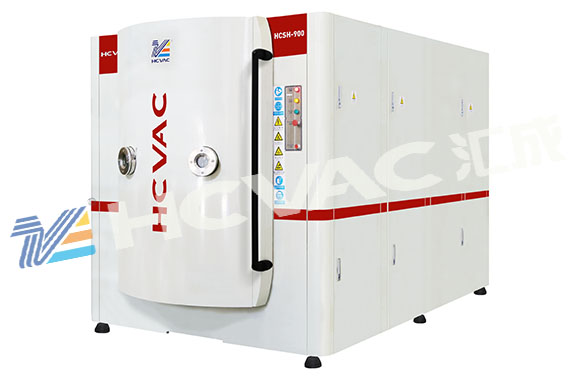The mechanical pump of the pvd coating machine is a very important part of the pvd coating machine and plays a vital role in the whole body. High pvd coating machine and continuous coating machine are the most widely used equipment for making vacuum conditions at present. Its relevant components and parts: mechanical pump, booster pump, oil diffusion pump, condensate pump, vacuum measurement system. I will introduce the composition and working principle of each part in detail below.

1、 Vacuum body - vacuum chamber
According to the different requirements for processing products, the size of the real cavity is also different. At present, the most widely used ones are 1.3M, 0.9M, 1.5M, 1.8M, etc. The cavity is made of stainless steel, which is required to be rust free and solid. Each part of the vacuum cavity is equipped with connecting valves to connect the air extraction pumps.
2、 Auxiliary air extraction system
The exhaust system is composed of "diffusion pump+mechanical pump+roots pump+low-temperature cold trap+polycold"
The exhaust process is as follows: the mechanical pump first pumps the vacuum chamber to a low vacuum state of less than 2.0 * 10-2PA, which provides a precondition for the subsequent vacuum pumping of the diffusion pump. Later, when the diffusion pump pumps the vacuum chamber, the mechanical pump is connected in series with the oil diffusion pump to complete the air pumping operation in this way.
The exhaust system is an important part of the vacuum system of the coating machine, which is mainly composed of mechanical pump, booster pump (mainly Roots pump) and oil diffusion pump.
Mechanical pump: also known as the front stage pump. The mechanical pump is the most widely used low vacuum pump. It uses oil to maintain the sealing effect and constantly changes the volume of the suction cavity in the pump by mechanical means, so that the volume of the gas in the pumped container expands continuously to obtain vacuum.
There are many kinds of mechanical pumps, including slide valve type (mainly used in large equipment), piston reciprocating type, fixed plate type and rotary plate type (the most widely used type at present, mainly introduced in this article).
Mechanical pumps are often used to remove dry air, but they cannot remove explosive and corrosive gases with high oxygen content. Mechanical pumps are generally used to remove permanent gases, but they have no good effect on water vapor, so they cannot remove water vapor. The main components in the rotary vane pump are the stator, rotor, shrapnel, etc. The rotor is inside the stator but different from the stator's mandrel, like two inscribed circles. Two shrapnel are installed in the rotor slot, and springs are installed between the two shrapnel, ensuring that the shrapnel is tightly attached to the inner wall of the stator.
Its two shrapnel alternately play two roles: on the one hand, it sucks gas from the air inlet, and on the other hand, it compresses the gas already sucked in to discharge the gas out of the pump. Every time the rotor rotates, the pump completes two suction and two exhaust. When the pump continuously rotates clockwise, the rotary vane pump continuously inhales gas through the air inlet, and continuously discharges the pump from the exhaust port, so as to realize the purpose of pumping air into the container. In order to improve the extreme vacuum degree of the pump, the pump stator is immersed in oil. In this way, enough oil is often kept in the gaps and harmful spaces to fill the gaps. Therefore, the oil plays a role of lubrication on the one hand, and sealing and blocking the gaps and harmful spaces on the other hand, to prevent gas molecules from flowing back into the space with low pressure through various channels.
The mechanical pump starts from the atmosphere, and its main parameters include the limit vacuum and the pumping rate, which is an important basis for the design and selection of the mechanical pump. The single-stage pump can pump the container from the atmosphere to an extreme vacuum of 1.0 * 10-1PA, and the two-stage mechanical pump can pump the container from the atmosphere to 6.7 * 10-2 Pa, or even higher.
The air extraction rate refers to the volume of gas that can be discharged per unit time when the rotary vane pump operates at the rated speed. It can be calculated by the following formula:
Sth=2nVs=2nfsL
Fs refers to the sectional area of the cavity at the end of inspiration, L refers to the length of the cavity, the coefficient refers to that the rotor has two exhaust processes every rotation cycle, and Vs refers to the end of inspiration when the rotor is in the horizontal position, where the volume in the cavity is the largest and the speed is n.
The exhaust effect of the mechanical pump of the
pvd coating machine is also related to the speed of the motor and the tightness of the belt. When the motor belt is loose and the motor speed is slow, the exhaust effect of the mechanical pump will become worse. Therefore, regular maintenance and spot inspection are required. The sealing effect of the mechanical pump oil also needs to be checked frequently. Too little oil can not achieve the sealing effect. The pump will leak air, and too much oil will block the suction hole, making it impossible to inhale and exhaust. Generally, The oil level should be 0.5 cm below the line.



